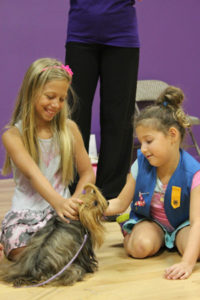Believe it or not, your dog might have the potential to be a therapy dog! Here’s a few “qualifications” he has to have to make the cut.
There is nothing that compares to the feeling one gets when an animal walks into a room. This “warm fuzzy” feeling is part of the human-animal bond that develops between people and their animal companions. The American Veterinary Medical Association (AVMA) defines the human-animal bond as “a mutually beneficial and dynamic relationship between people and animals that is influenced by behaviors that are essential to the health and well-being of both. This includes, but is not limited to, emotional, psychological, and physical interactions of people, animals, and the environment.”
The human-animal bond has proven to be effective in not only making people feel good, but to be effective for medical and rehabilitation programs, and beneficial for children and individuals with special needs. This is why therapy dogs can be so important for improving our well-being.
One of the greatest challenges we have as a therapy dog organization is working with individuals who really want to do therapy work, but whose dog is not appropriate. Unfortunately, we see many dogs working in pet therapy who are not really enjoying the experience and would likely be much happier at home snuggling with their owner and no one else. Therapy dogs must love people and seek out interactions with people other than their owner, immediate family, and friends. A dog that doesn’t enjoy interacting with strangers can quickly become stressed and unpredictable, especially when in unfamiliar surroundings.
It is important to understand that not all therapy dogs are appropriate for working with all populations. A dog that thrives on providing therapy to residents of a nursing home may panic when around children or individuals with disabilities, where an individual’s actions may be unpredictable for the dog.
Dogs who work with children and special needs individuals require a higher tolerance threshold than therapy dogs that work in nursing homes and hospitals. Before working with these special populations, a dog should have experience working with adults that are more predictable. Letting the dog have a level of comfort interacting and being handled is important prior to introducing them to the stressors of children and individuals with special needs.
What do we look for in a therapy dog that works with children, children with autism spectrum disorder and related disorders, or other special needs? First, these dogs must have a rock solid temperament. They must not be easily startled by loud noises, erratic behavior or the sudden shift of a person’s mood or behavior. The dog must be predictable. Most importantly, the dog must enjoy these interactions. Placing a dog in these high stress situations that he or she does not enjoy is a recipe for disaster.
Only after dogs have had experience working in a nursing home or other such facility should they be observed around children of all ages, genders, and ethnic groups. Does the dog approach them willingly? Does he or she mind being handled inappropriately? How does the dog react if one of the children begins screaming or exhibiting behavior like flapping or jumping up and down? What is the reaction of the dog if the children start clapping or pounding on a table in tandem and chanting (which is something we frequently see in children with ASD)?
Careful observance of the dog and the handler in these situations is critical to determining if a dog is appropriate for working with special populations or as a therapy dog in general. The handler and dog must work well as a team and it is critical that the handler know their dog and understand their dog’s body language. These are all things that come with experience and continual training with your dog.
By having your dog carefully evaluated specifically for the populations the two of you will be interacting with, you will not only make sure that the people have a great experience, but that the dog has one too. Being “mutually beneficial” is what the human-animal bond is all about.










